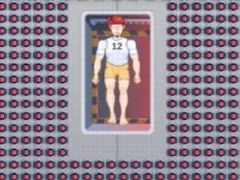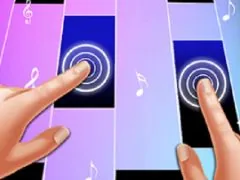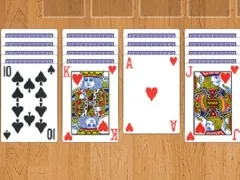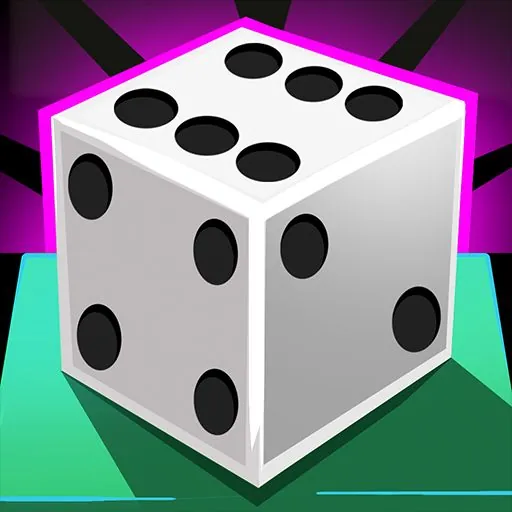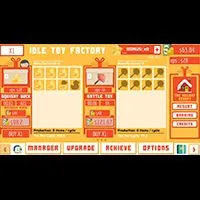2048
SIMILAR GAMES
Description
2048 - Unblocked WTF
About 2048 - Unblocked WTF
Welcome to the definitive guide for mastering the captivating world of 2048. This elegantly simple yet profoundly challenging puzzle game has captured the attention of players worldwide, offering a mental workout disguised as pure entertainment. At its heart, 2048 presents a grid, typically a 4x4 matrix, where numbered tiles dynamically shift and merge. The objective is deceptively straightforward: combine tiles of identical values to create a tile representing the number 2048. However, the path to this coveted tile is paved with strategic thinking, careful planning, and an understanding of the game's subtle mechanics.
The premise of 2048 is built upon a foundation of basic arithmetic and spatial reasoning. Players interact with the game by swiping in one of four directions – up, down, left, or right. Every swipe triggers a cascade of movements: all tiles on the grid slide as far as possible in the chosen direction. If two tiles with the same number collide during this movement, they merge into a single tile whose value is the sum of the two merged tiles. For instance, two '4' tiles combine to form an '8' tile, two '8' tiles form a '16', and so on, doubling in value with each successful merge. Crucially, after each valid swipe, a new tile, either a '2' or a '4', randomly appears in an empty space on the grid. This constant influx of new tiles adds a layer of unpredictability and urgency, forcing players to constantly adapt their strategies.
The minimalist design of 2048 belies its deep strategic potential. While the core gameplay is accessible to anyone, achieving higher scores and the elusive 2048 tile requires a level of foresight and pattern recognition that can be honed over time. The game is a constant balancing act: you must merge tiles to clear space and increase values, but each merge also limits future movement options. Understanding how to control the placement of new tiles and how to organize your existing tiles for optimal merging opportunities is key to long-term success. The game's inherent challenge lies in its ability to remain engaging and thought-provoking, even after countless playthroughs.
The Genesis and Appeal of 2048
The original 2048 game was created by Gabriele Cirulli, an Italian web developer, and released in March 2014. Its viral spread across the internet was rapid, attributable to its simple yet addictive gameplay loop and its availability on web browsers, making it easily accessible across various devices. The game's clean, uncluttered interface, coupled with its satisfying merging animations, contributed to its widespread appeal. It offered a mental challenge that was engaging enough to keep players hooked, yet not so complex as to be intimidating. This perfect blend of simplicity and depth is a hallmark of many successful puzzle games, and 2048 exemplifies this beautifully.
The core appeal of 2048 lies in its inherent satisfactions. There's a unique pleasure in watching tiles cascade and merge, culminating in a satisfying numerical increase. The game taps into a fundamental human desire for order and progress. As players strategically maneuver tiles, they are creating order out of the random appearance of new numbers, building towards a clear, defined goal. The exponential nature of the tile values – 2, 4, 8, 16, 32, 64, 128, 256, 512, 1024, and finally 2048 – creates a compelling sense of progression. Each successful merge feels like a small victory, pushing players closer to the ultimate objective.
Furthermore, 2048 offers a different kind of challenge compared to more action-oriented games. It requires patience, deliberation, and the ability to think several steps ahead. This makes it an ideal game for moments when players want to engage their minds without the high-pressure environment often found in other gaming genres. It’s a game that can be played in short bursts or extended sessions, always offering a fresh set of challenges with each new game started. The randomized nature of tile generation ensures that no two games are ever exactly alike, promoting replayability and continuous learning.
Understanding the 4x4 Grid Mechanics
The 4x4 grid is the canvas upon which the strategic brilliance of 2048 unfolds. This compact space is critical; its size dictates the density of tiles and the number of available empty slots at any given time. Understanding how tiles move within this confined area is paramount. When you swipe, for instance, to the right, every tile on the grid attempts to move as far right as it can. If it encounters another tile of the same value, they merge. If it encounters a tile of a different value or the edge of the grid, it stops.
The concept of 'slipping' is also important. Tiles don't just move; they 'slip' into available spaces. This means a tile might not immediately merge with the first tile it encounters if there's an empty space between them. It will continue moving until it hits another tile or the boundary. This behavior is consistent across all four directions, but mastering how to exploit this sliding mechanic to set up future merges is a key skill.
The introduction of new tiles after each move is where the true challenge lies. These new tiles, always a '2' or a '4', can appear anywhere in an empty space. A poorly executed move can lead to a new tile appearing in a critical location, blocking your intended merges or trapping valuable high-numbered tiles. Therefore, it's often advisable to keep at least one row or column relatively clear, or to maintain a corner where your highest tiles can be consolidated and protected. This strategic arrangement is what separates novice players from those who consistently achieve the 2048 tile and beyond.
Essential Strategies for Reaching 2048
Achieving the 2048 tile is not a matter of luck; it requires a consistent and well-thought-out strategy. One of the most widely recommended and effective strategies is the "corner" or "snake" method. This involves consolidating your highest value tiles in one specific corner of the grid, typically the bottom right or top left. The idea is to maintain a monotonic arrangement of tiles in that corner, where the highest value tile is adjacent to the second highest, and so on, forming a chain.
To implement this, you will predominantly use only three directions of movement. For example, if you choose the bottom right corner, you would primarily swipe left, down, and right. You would avoid swiping up as much as possible, only using it when absolutely necessary to clear a path or make a critical merge that cannot be achieved otherwise. This directional constraint helps to keep your highest tiles clustered in your chosen corner, preventing them from being scattered across the grid.
The introduction of new '2' and '4' tiles becomes more manageable when you have a predictable area for them to appear and a clear strategy for merging them. By focusing on merging smaller tiles together and systematically moving them towards your highest consolidated tile, you gradually build up the chain. For instance, if your highest tile is in the bottom right, you'd aim to merge '2's and '4's on the right edge, moving them down, and then merge those results into your larger tiles. This systematic approach minimizes the risk of getting blocked by stray high-value tiles.
Advanced Techniques and Considerations
Beyond the basic corner strategy, advanced players often think about maintaining a "chain" of tiles. This means ensuring that tiles of decreasing value are placed next to each other in a logical order. For example, if you have a 512 tile in your corner, you would ideally want to have a 256 next to it, then a 128, and so on. This allows for smooth merges as new tiles are generated and existing ones are moved. It's about creating a predictable flow of merges rather than random combinations.
One critical aspect of advanced play is understanding the consequences of each move. Before swiping, take a moment to visualize where the tiles will end up and what new tile is likely to appear. Consider how that new tile might disrupt your established order or create an opportunity for a powerful merge. Sometimes, a seemingly "bad" move that scatters tiles can be beneficial if it sets up a chain reaction of merges that ultimately leads to a stronger board state.
Furthermore, skilled players learn to anticipate the worst-case scenarios. What happens if a '4' tile appears in the most inconvenient spot? How can you recover from that? This involves building resilience into your strategy. Having a few empty spaces strategically placed can provide breathing room. Also, understanding when to break your primary directional rule (e.g., swiping up in a bottom-right corner strategy) becomes important. These occasional, calculated deviations can be necessary to prevent a game-ending situation.
Maximizing Your Score in 2048
While reaching the 2048 tile is the primary objective for many, the game can be played to achieve even higher scores. Once you achieve the 2048 tile, the game doesn't end; it continues, allowing you to aim for 4096, 8192, and beyond. To maximize your score, you need to continue applying and refining your strategic approach. The principles remain the same: controlled merging, strategic tile placement, and careful planning.
The key to scoring beyond 2048 is to maintain the integrity of your highest tiles and continue to build them. This means not sacrificing high-value tiles for minor merges if it jeopardizes your established structure. It's often more beneficial to create a high-value tile and then spend several moves clearing out smaller tiles to make space for it, rather than merging smaller tiles haphazardly and risking the dispersal of your valuable larger numbers.
Another aspect of high scoring is efficiency. Every move should ideally contribute to progress. Avoid making moves that don't result in a merge or don't contribute to better tile positioning. The more efficient your moves, the more opportunities you have to generate new high-value tiles and work towards the next power of two. The game rewards patience and deliberate action; rushing can often lead to mistakes that are difficult to recover from when aiming for exceptionally high scores.
Dealing with Randomness and Obstacles
The inherent randomness of new tile generation is perhaps the most frustrating and challenging aspect of 2048. There will be times when a '4' tile appears directly in the path of your most crucial merge, or when the available empty spaces are scattered in a way that severely limits your options. Effective players don't let these moments derail them; they adapt.
When faced with a difficult board state, it's important to take a deep breath and assess your options. Sometimes, the best move isn't the most obvious one. It might involve sacrificing a smaller tile to clear a path for a larger one, or making a series of small merges to create an opportunity for a significant one later. The ability to recognize and exploit these less obvious moves is a hallmark of experienced players.
Furthermore, understanding how to "bait" the game can be useful. By strategically leaving certain spaces open or arranging tiles in a particular way, you can sometimes influence where the new tiles appear, or at least increase the probability of them appearing in less disruptive locations. This requires a keen observation of the game's mechanics and a willingness to experiment with different arrangements.
The Enduring Fascination of 2048
The enduring appeal of 2048 stems from its perfect synthesis of simplicity and strategic depth. It's a game that can be learned in minutes but offers a lifetime of challenges. Its accessible interface means anyone can pick it up and start playing, but its nuanced gameplay rewards dedication and thoughtful play. The pursuit of the 2048 tile, and subsequently higher scores, provides a continuous sense of accomplishment and a compelling reason to keep returning.
The game is also a testament to how a well-designed puzzle can engage the mind in a way that is both stimulating and satisfying. It exercises logical reasoning, pattern recognition, and foresight, all while providing a sense of enjoyment. The minimalist aesthetic ensures that the focus remains squarely on the gameplay, without distractions. This allows players to become fully immersed in the strategic puzzle presented by the shifting tiles.
In conclusion, 2048 remains a beloved classic in the world of puzzle games. Its elegant design, addictive gameplay, and profound strategic possibilities ensure its continued relevance and popularity. Whether you are a casual player looking for a quick mental diversion or a dedicated strategist aiming for ever-higher scores, 2048 offers a rewarding and endlessly engaging experience.
2048 invites players into a subtly complex puzzle where mathematics meets strategic maneuvering in a confined space. At its core, the game’s premise is seemingly straightforward: swipe to move and merge tiles of equal values, exponentially doubling them towards the target of a 2048 tile. Yet, beneath its minimalist interface lies a rigorous test of planning and foresight. Each swipe fills the 4×4 grid slightly, introducing new “2” or “4” tiles.
Strategic Harmony in Numbers
The essence of 2048’s challenge blooms in managing the numeric landscape. Players must cultivate a tactical harmony where each move is part of a broader strategy. The goal is to avoid isolating high-value tiles which could block potential merges. Advanced players often adopt a corner strategy, anchoring their highest value tile in a fixed position to build around. This methodical approach turns each session into a cerebral dance, where every slide, every merge, and every new tile plays into a grander scheme of spatial economy and numeric potential.
2048’s allure springs from its blend of simplicity and cognitive engagement. It doesn’t just challenge players to hit a numeric target but encourages the development of a nuanced strategy to navigate its tight, evolving board. Each game is a fresh mental workout, a puzzle that’s as addictive as it is rewarding, drawing players back to surpass their personal bests and redefine their strategic limits. This game transforms a simple grid and a series of numbers into an arena of infinite possibilities and mind-bending puzzles, proving that true challenge often comes in the most unassuming forms.


